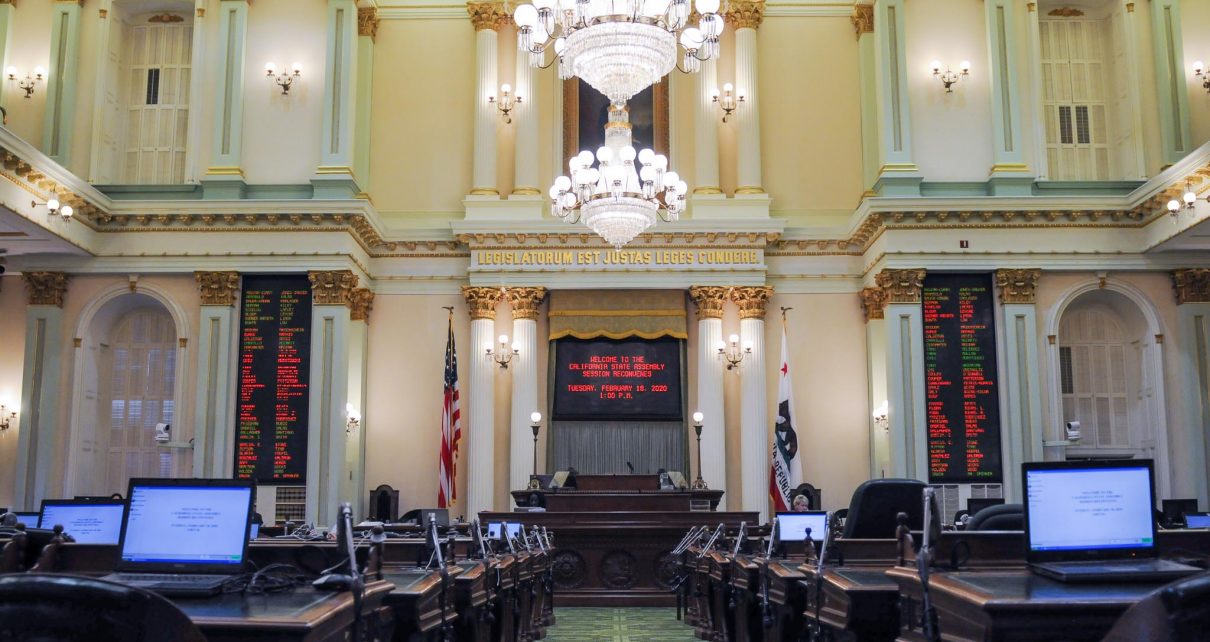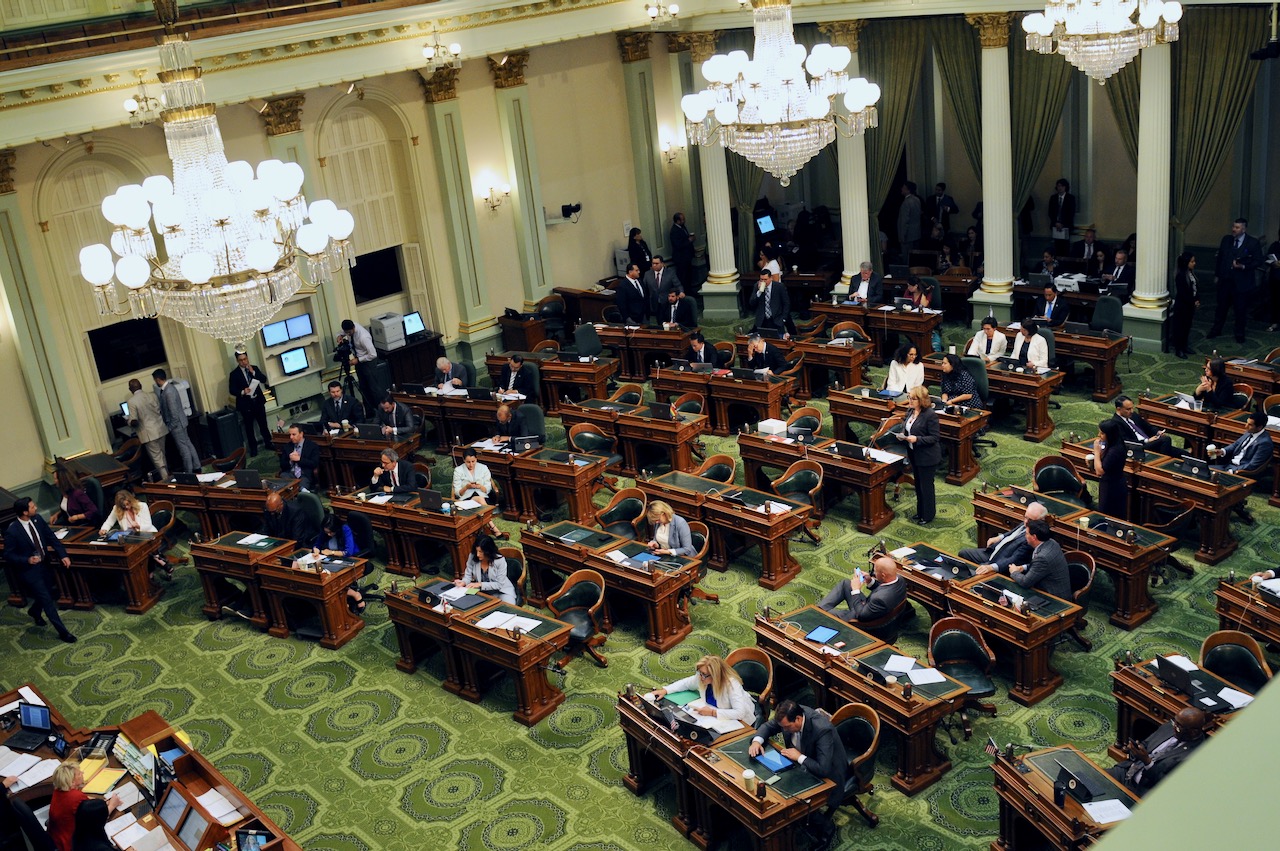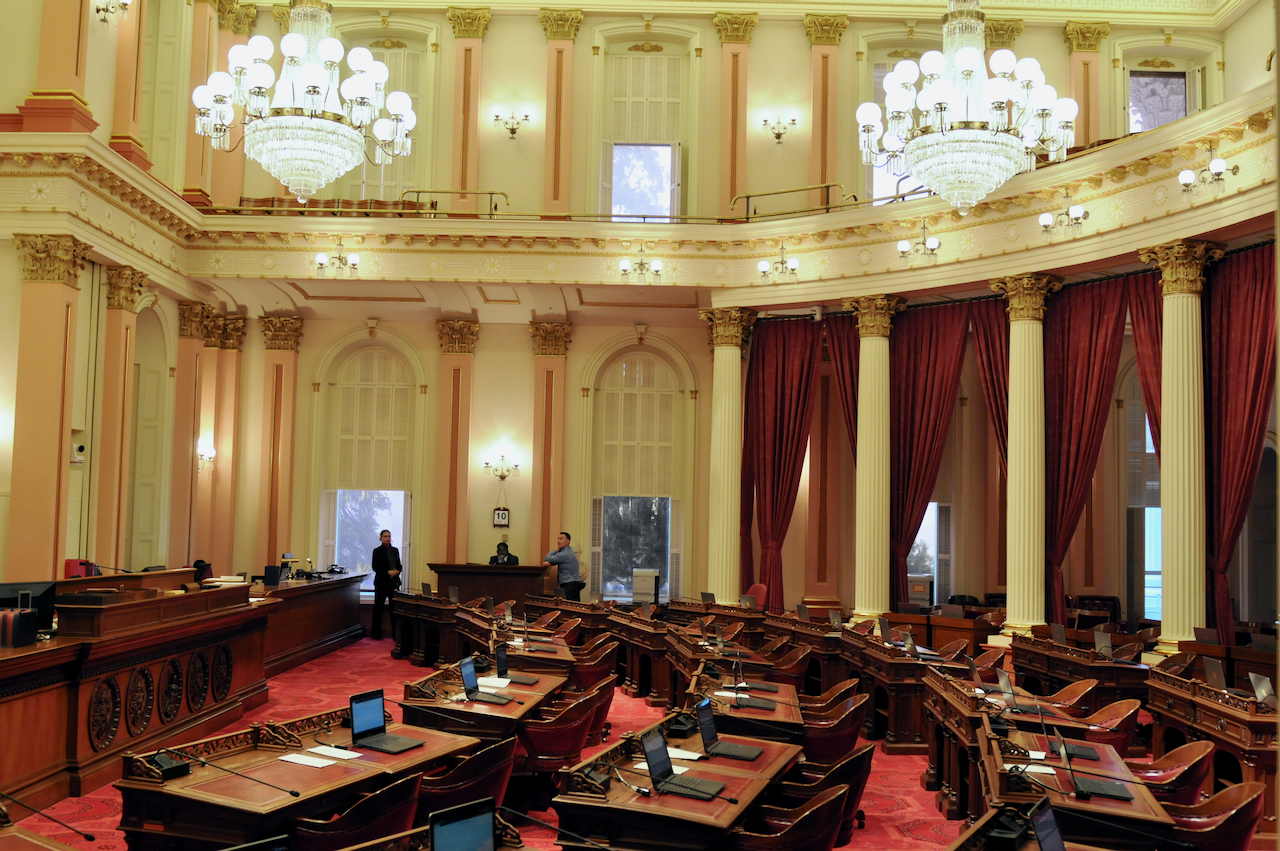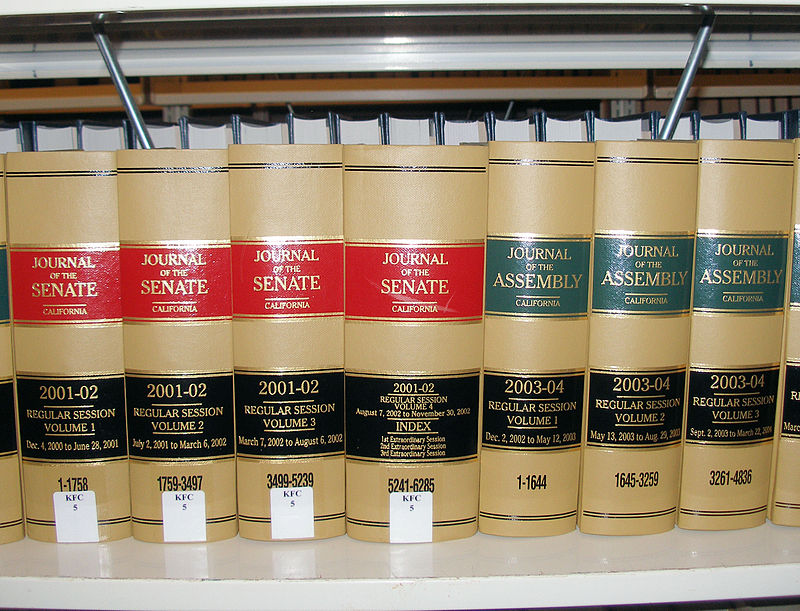
California State Assembly. (Photo: Kevin Sanders for California Globe)
Would MORE Legislators Better Govern California?
A larger Legislature would not mean a more expensive Legislature
By Thomas Buckley, December 13, 2021 2:20 am
Author’s note – I’m sorry you just spilled – or worse – your coffee or whatever all over your screen when you read the headline. I suggest taking a minute to clean up and then take a deep calming breath before beginning the article because it may actually make some sense….there, now all better? Let’s begin.
California has a power problem, and not the one that involves residents being asked not to wash their clothes until 11:30 at night.
The problem is the concentration of too much power in too few hands and too often in the wrong hands.
Power itself is a zero-sum construct. While there are many choices as to how to wield (or not wield) available power and exactly who – or what – has the larger slice of the power pie at any given time can change (in Sacramento, admittedly, right now that is purely in theory), power itself neither expands nor contracts. Some obtain power to use it, some seek power to keep others from using it – the variations are myriad but it is always simply there.
In light of the events of COVID, it should be noted that the decision to use – and how to use – power can seem to grow unabated in certain situations. However, the pandemic-specific actions taken were under the rubric of existing legal authority so while “power,” in its most basic sense, did not grow its use and/or abuse as it relates to the lives of Californians certainly did. As such “emergency measures” are supposed to be implemented sparingly and only for a very limited amount of time they cannot be said to reflect a “growth” in the “power pie,” merely a re-distribution of the size of the slices from the people to the authorities. The fact that they were not used sparingly, are largely still in force, and caused untold collateral damage is due to the actions of those who currently wield power.
One of the core reasons for California’s problem is the comparatively tiny state legislature which hyper-concentrates power, a concentration of power that may in fact be wielded in large part by those who control the legislators. In Sacramento, the actual wielding of power for benefit is not done by the two houses – the Assembly and the Senate – but by the “third house:” the permanent lobbyist/consultant/bureaucrat/political action committee/donor/interest group conglomeration, a.k.a the Blob.
To paraphrase Hannibal Lecter, the Blob, as its “first principle,” covets…power. Nothing else – especially individual voters – matters.
California is one of only two states (the other being Texas) that has its state Senators represent more people than its members of Congress. Additionally, no other state comes close to having its Assembly members (usually referred to as “Representatives”) represent so many people. Based on the size of both houses of the legislature, California’s get one member for every 333,000 people; the next two states, Texas and Florida, have one member per half that number of people.
These outsized legislative districts (momentarily putting aside the on-going – and problematic – re-districting process, coverage of which can be found here, have numerous drawbacks.
First, and most obviously, the average resident has little or no ability to interact directly (or even indirectly) with their voice in Sacramento which can create an information and opinion bubble around each legislator, leading to certain measures that would never be approved – if honestly described to the public – breezing through the capitol (insert your most personally egregious example here and, since most propositions are not honestly described to the public, we can let that issue rest for now).
Second is the issue of money – it costs about $1.3 million to run a credible state Senate campaign and about $700,000 on the Assembly side. With the dearth of direct local connections (and fundraising opportunities) being cultivated (or even possible) by prospective legislators, it becomes nearly impossible to mount an effort without participating in the “Sacramento primary” before even considering a run for office.
In a nutshell, the “Sacramento primary” involves first hiring a lobbyist/consultant/fixer, having them set up meetings and such with the powers that be, flying Southwest to the capitol, and then going through what is essentially a beauty pageant (or livestock auction) to assure the Blob that you have a chance, are not too personally repellent, and that you will not be too pushy when it comes to challenging the status quo. If the white smoke rises and you are chosen, the funding flood gates open and, in too many cases, the actual voting becomes a mere formality.
This process is also incredibly handy for the candidate – instead of “dialing for dollars” around the district to squeeze $99 dollars out of your neighbors (each of whom will remind you of the donation when they want a ticket fixed) you are just given a few handfuls of very large checks (sometimes literally even all at once, like the wedding scene in “Goodfellas”) and your work is done. Easy Peasy.
And what does the permanent Sacramento Blob (or Mob, if you will) get out of this process? Lobbyists and consultants will claim that money is merely about ensuring access, which is actually important in a town where lobbyists and consultants and such outnumber legislators by a factor of at least a bazillion. But in fact what the Blob gets is fealty, increasing the power of the Blob, leading to a cashier check and wine fueled feedback loop that directly tightens the grip Sacramento has on the lives of everyday Californians. Bills literally written by lobbyists are presented, “gut and amend” events occur with alarming frequency, ideas that do not serve the Blob (or, in the case of EDD reform, that the Blob do not care about) are crushed, and the status gets even quo-ier.
So how would having even more legislators help the situation? Let’s look at a scenario in which the size of both houses is tripled.
First, campaign costs drop significantly making it actually possible to run a local race with local money obviating, in many cases, the need for the “Sacramento primary.” The cost of a credible run for office drops to about $200,000 for an Assembly seat, a more manageable number.
Second, the residents of each district become more important. Currently, a legislator can safely ignore the concerns of vast swaths of their district; with a smaller universe of votes to draw from, that becomes far more difficult (when a person represents 500,000 people you can skip the local Woman’s Club meeting – with only 170,000 or so people you do so at your own peril).
Third is the cat herding issue. In the case of the Senate, getting 21 people (who you gave truckloads of money to) to say “yes” to your idea (no matter how boneheaded) or to agree to your demands (no matter how egregious) is a doable proposition for practically anything. With a larger legislature, the money involved would be much less and the legislative bar much higher because lobbyists, bureaucrats, etc. would have to convince 61 different – and less beholden – people that, for example, PG&E is not the devil incarnate and should not be forced to spend billions of dollars to fix their grid so people won’t keep getting killed by the company.
The Blob has taken the current truth of the matter to the extreme and it is far from uncommon – right now – for a half-dozen lobbyists and/or PACs and/or other big donors with widely varied interests to invite a half dozen electeds to the same event, stand around with sticky drinks glasses, chat for an hour or so, and then give each of the legislators a half dozen checks (true fact – there are legislators who have done three of these types of events back-to-back in one evening).
There are downsides to the idea, granted. In theory it would be possible to flood the newer smaller district with so much money that the costs remain out-of-reach to a more grassroots campaign. While that is true, just the sheer number of races and districts and situations would make any such widespread effort unsustainable over time, thereby at least weakening the hold of the Blob. Also, in smaller, more local, more “grounded” races voters do tend to look askance at truckloads of “outsider” money pouring in and become can become leery of the candidate. And, finally, money isn’t everything and may not always be able to make up for a slippery candidate with no real ideas who runs an over-consulted, deceitful campaign – looking at you, Meg.
So as to quell certain fears, a larger legislature would not mean a more expensive legislature. For the greatest positive impact, expanding the legislature would have to go hand-in-hand with the job becoming part-time (forcing the legislator to remain “closer to the people”) and entail a smaller staff for each legislator. For legislators who are committee chairs and in other leadership roles, it is possible they could be full-time (the state is admittedly rather large and complex), but who gets to do what would be decided amongst themselves, thereby setting up another important “avenue of discord” to keep the Blob from re-forming their old power blocks.
Another potential avenue of reform is the abolition of term limits (Author’s Note – there goes the coffee again – Sorry).
In the BBC’s “Yes, Minister” – one of the most terrifyingly real – and truly hysterical – look at how government actually works – a pair of major domo British bureaucrats sum up the situation nicely: “Power goes with permanence. Impermanence is impotence. And rotation is castration.”
If you have not seen the show, here is a link to the Amazon Prime page. It is also on standalone BritBox and vast swaths of it can be found on YouTube. Anyone interested in politics needs to watch it.
This applies exquisitely well to Sacramento. PG&E, to purposefully kick an evil but sadly not dead horse, for example has been expertly manipulating the levers of power in the capitol for more than a century (too bad they are better at that than manipulating actual power). And they – short of the Second Coming or the actual revolution – are primed to continue to do so for the next 100 years.
To be blunt, they’re not going anywhere, they will not change their lobbying goals, they do not have to change how they operate – their goal is a status quo that has been extremely extremely good to them (and their minions like Governor Newsom). And, very importantly, they have time on their side, which is analogous to another organization – the Roman Catholic church. Before the more recent horrors forced the Church’s hand, an official once stated quite bluntly: “The Catholic Church has very specific views about the sale of property. We don’t have to pay taxes, we’ve been here for 2,000 years, and, short of the Resurrection, we’re going to be here for 2,000 more years so we can wait for our price.”
Like the Church, PG&E, and other parts of the Blob, can wait, too, for its price and simply watch as legislators rotate in and out of office. This is not merely an observation, but a specifically planned (and privately acknowledged) exercise by the permanent Blob – it can simply wait until a problematic legislator on an important committee is gone because it knows for a fact when that will happen. It may be inconvenient, but when it comes to the larger, over-arching goals of the Blob, neither time nor even personnel (the lobbyist may change but the message doesn’t) is a factor.
A former legislator – when Assembly members were limited to six as opposed to the 12 years they are now – observed that the first year in office is spent getting to know the place, the second is making sure you get past that first re-election, and the sixth is trying to figure what to do next, leaving only three actual years of practical governance. The Blob was in heaven.
Term limits, as a concept, may seem good and they guarantee that “the bums are thrown out” eventually, but the fatal flaw is that, at least in California, they throw out the wrong bums. Longer term limits could be considered but they would have to be long enough to change the behavior and tactics of the Blob and, as noted, that could take quite a long time.
Another possible implication of smaller districts is a shift in the impact of the “jungle primary.” Originally intended to force candidates of all parties to “moderate” their positions so as to be able to draw from a larger pool of voters, in practice in California this has not come to pass – at all. The concept was first introduced in America by Louisiana Democrats, who made no bones about publicly stating that the goal was to drive the last nail into the coffin of what was then a purely vestigial Republican Party (and you think California’s party registration numbers are lopsided? – not even close to what they were in the Pelican State at the time).
The plan, however, backfired spectacularly on the Democrats as they did not impose enough party discipline to keep the number of candidates in the primary low enough to guarantee a Dem vs. Dem November vote and Republican percentages in those contests increased, making the party seem a bit more plausible. And then as the national Democratic Party drifted further leftward – particularly on social and environmental issues – the Republicans were actually poised to pounce. They did and Louisiana is now – after more than 120 years of Democrat control – a reliable “red state.”
California numbers tell a different tale. In 2020, there were 12 “single party” November votes – 10 of them (12 percent of the entire Assembly) involved two Democrats. In two other races the Democrat beat a third-party candidate and in three others the Democrat had exactly zero opposition, even in the primary. Combining the current “rotten borough” districting system with the jungle primary has been an unmitigated boon for the Democrats.
Smaller districts and, therefore, more locally-based and themed and funded campaigns could actually tilt the jungle primary back towards its original intent. Of course, it must be noted, that no matter how many districts there are they need to be created properly and fairly.
By doing everything, including, counter-intuitively, having more elected and at least theoretically publicly accountable officials – to melt the Blob until it oozes back into the Sacramento sewers, the residents of California may actually be able to live – for better or worse – in a democracy once again.
There now, pour yourself another cup or, better yet, something with a bit more kick.
End Note – California happens to have a, for the lack of a better term, corporate/leftist (neo feudal) power structure. While the details would be different, the essence – and intent – of this piece hold true for any similar blob no matter where it may be and no matter what shade of the political spectrum it happens to clothe itself in.
- Benefit Fraud Problems and Solutions - November 7, 2024
- A Little Exit Poll - November 5, 2024
- Tomorrow’s Headlines Today! - November 5, 2024





Every voter is in fact a lawmaker.
Welcome to the party (eight years tardy). This is the basis of the State of Jefferson (soj51.org). The restriction on 40/80 dates back to the racist days of the 1870’s legislature. This State has some pretty crappy constitutional roots, but far be it from D’s to make any constructive change. Throughout history, this is the way they made/like it.
The author here –
In looking through the comments here and on Facebook and Twitter, I came across a few concepts I thought worth addressing.
First, the idea of having one state senator per county – like is done with states at the federal level – is really interesting. It would definitely increase the diversity of the body, particularly when it comes to the geographic aspects. Sadly, though, diversity of geography is not one of the “protected” diversities so it may be a tough road to get through. That being said, it really has a lot of merit and should be considered.
Second, clearly the voting system – no matter the representation concepts – has to be improved and made more secure. From the districting process to voter rolls to registration to vote-by-mail as a default to voter ID to ballot harvesting to “trust us – we know it’s strange but the dog only eats Republican ballots – really!,” a top-down reform of the whole shebang is long overdue.
As to the idea that we do not need more inmates running the asylum, I think that analogy misses the mark a bit since the major point of the piece is that the inmates (legislators) are NOT now running the asylum. Of course, another reform not addressed are lobbying restrictions (only one registered lobbyist at an event, limits on what can be spent, etc.) would be helpful in reducing the power of the people who do actually run the state now.
Anyway, thanks for the comments and the ideas and for reading!
Distributing state senators by county would really alter the scales. Instead of a supermajority, the CA senate will most likely still be a Democratic majority although barely.
In the most recent election, the Yes on recall got 27 counties with No on recall, 31. 27/58 would be 46%, a vast improvement from 9/40 senators which is 23%. It effectively means Republicans can filibuster and moderate Democrats, if there are, can hold sway on bills.
https://elections.cdn.sos.ca.gov/sov/2021-recall/sov/complete-sov.pdf
However, it’s debatable whether it’s great to do it. Counties with less population has as much power as counties with large population so it’s not represented by population equally.
Yes, I believe it’s called a Republic.